Search Results for 'jas'
Did you find what you wanted ?
Tue 12 May 2015
Posted by Steve under
Reviews[6] Comments
Reviewed by Mark D. Nevins:

KEN BRUEN – London Boulevard. Minotaur Books, US, hardcover, November, 2009; softcover, November 2011. First published in the UK, The Do-Not Press, hardcover, 2001. Film: 2010, with Colin Farrell and Keira Knightley, directed by William Monahan.
If you’ve been thinking about trying out Ken Bruen, London Boulevard is not a bad entry point. You’re not committing to the Jack Taylor or Brant/Roberts series, and you’ll be avoiding the broad parody of his “Max” collaborations with Jason Starr (that’s the absolute WRONG place to start with either writer).
London Boulevard is a sort-of adaptation of Sunset Boulevard displaced to (guess) London, and it’s a well-written, fast-moving, and stylish neo-noir. I guess the only strike against it as a starting point for Bruen is that it’s set in England not Ireland, but Bruen seems comfortable in both locales, and this book offers much of what you’ll either really like or dislike about Bruen as a writer: quick, telegraphed prose with lots of white space on the page; melancholy interior monologues; wise-ass dialogue; lots of hip pop culture references; and a dark brooding Irish pessimism about life and human nature.
This is not the best Bruen I’ve read (I am soon going to get back into the Taylor series), but is a solid and pleasing work of crime fiction and a real page-turner. (I have yet to see the film, but now I can.)
Tue 24 Mar 2015
Reviewed by DAN STUMPF:

RIMFIRE. Lippert/Screen Guild, 1949. James Millican, Mary Beth Hughes, Reed Hadley, Victor Killian, Henry Hull, Fuzzy Knight, Chris-Pin Martin, Glenn Strange, Jason Robards Sr., I. Stanford Jolley and the ubiquitous (at Lippert) Margia Dean. Written by Ron Ormond, Arthur St. Claire and Frank Wisbar. Directed by B. Reeves Eason.
Not a terribly good movie, but an unusual and intriguing one, Rimfire offers James Millican as an undercover cavalry officer in search of a purloined gold shipment. Early on he stops a stagecoach robbery (masterminded by that stalwart of the genre, the fancy-vested saloon-owner) and gets a job as deputy for the local sheriff.
All pretty standard stuff, but it happens that one of the stagecoach passengers is a savvy gambler known as the Abilene Kid (saturnine Reed Hadley) who knows a thing or two about the local bad guys, and in short order, he’s framed for cheating at cards with a marked deck and promptly hanged by the law-abiding citizenry.

Well I wasn’t expecting that. Nor the next part where a ghostly shadow shows up at odd times and starts murdering the rest of the cast, leaving a playing card at the scene of each slaying.
The origins of this bit aren’t far to seek. Co-writer Frank Wisbar is best known for writing/directing Strangler of the Swamp (PRC, 1946) which also featured the ghost of a wrongly-hanged man exacting revenge. Director B. Reeves Eason, who helmed such off-beat adventures as Undersea Kingdom and Darkest Africa (both Mascot, 1936) knew his way around the world of low-budget thrills, so Rimfire achieves a certain eerie resonance as we see each doomed victim suddenly shrouded by shadow, staring fearfully into the camera as a sepulchral voice tells him his time has come. And some of the murders are unusually grim for a B-western.

Alas, however, and also alack while you’re up, the makers of this thing opted for a fairly conventional “surprise†ending which I saw coming about 10 minutes in. Damn shame, that.
Along the way though there’s some fairly chilling fun to be had, and if Rimfire never makes it into the ranks of Creepy Classics or Western Noir, at least it offers something a little out the ordinary to keep you watching.
Thu 26 Feb 2015
An Interview with LAWRENCE KINSLEY
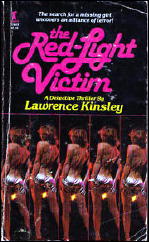
It took a couple of weeks after I posted a review of The Red-Light Victim (Tower, 1981), a paperback original by Lawrence Kinsley, to track the author down, thanks to Google and the assistance of Mark Nevins, a mutual friend.
You probably should go read (or re-read) the review again, before continuing. Here’s the link. I’ll reuse the cover image that I used then, but you’ll probably find it helpful to go back to read what I had to say about the book before reading Larry’s own comments on it. What I will tell you here, though, is that it’s a private eye novel, the PI in this case being Boston-based Jason O’Neil. In the background is the anti-nuclear movement of the early 1980s.
This interview consists of a long comment that Larry left on that earlier blog post, somewhat edited to fit an interview-type format, along with his answers to a few additional questions I asked him.
Steve (SL): I’m glad I was able to get in touch with you, and of course it’s good that you’re still around to be gotten in touch with. Can you tell us something about the book, your reaction to the cover, and how it happened that a second book never happened?
Larry (LK): No, the nukes haven’t gotten me yet! Larry Kinsley is still alive, and am the author of The Red-Light Victim, though I had nothing to do with the cover pic! – that was strictly Tower Pub, which I doubt ever even fully read the book! In fact, I pretty much had an agreement with a scientific group named the Union of Concerned Scientists to review and publicize the book when it came out, but as soon as they saw the cover the agreement vaporized.
Don’t know how much anyone would be interested in my subsequent tale of woe concerning the book. Suffice it to say that after I sold a second Jason O’Neill detective novel to Tower Pub, The Salem Cult, a year later, they went out of business three months before that book’s fall 1982 release date. Worse, they literally stole away in the middle of the night from their Park Avenue offices, taking all of my royalties from Red-Light with them! These included sales of the book to at least three different European countries, with translations, what Tower had previously told me was unprecedented for one of their mystery/detective books.
As my writing career up to then had netted me approximately eighht cents an hour, and as at the same time my agent retired suddenly and I couldn’t re-market the second O’Neil book since Tower had already paid for a 15 year copyright, I decided at that time, aided by a sudden move out of the Boston area to Florida because of a work offer in the video retail business, to put my career on hold.
Red-Light had been up for an Edgar as best first mystery novel, but didn’t win, I was told by Mystery Ink’s librarian, because Tower did nothing to push the book. Although I had other O’Neill books outlined, I simply for a number of reasons both financial and personal couldn’t continue at that time. Little did I know that my hiatus would last well over 30 years!
SL: What have you been doing in the past 30 years?
LK: I have recently retired from the retail business and am back in the writing game, though of course O’Neill himself is vastly out of date – in fact he took up residence in the retirement home for old detectives some time ago – but I do have an historical novel and a WWII spy novel in the pipeline, though no agent as of yet.
I also spent several years writing a non-fiction book on the architect Frank Lloyd Wright’s campus of buildings at Florida Southern College near where I currently live, which is currently being looked at – no decision yet – by the History Press.
SL: Thanks for all information about The Red-Light Victim and what you’ve been doing since it was published. Do you now own the rights to the book? You mentioned that Tower had a 15 year long contract for the copyright, but that’s long past. And in that regard, have you considered finding a publisher specializing in reprinting oldout-of-print mysteries? There are quite a few actively putting out books today.
LK: You’re very welcome. I’m always interested in letting the reading public know something of the behind the scenes writing game.
I don’t know much about publishers interested in publishing out of date mysteries – mine was so topical I really didn’t think about a re-release over 30 years later. Maybe by now enough people have come along who thing that the China Syndrome is a casual drug that there might be some re-interest in the topic. (In 1982 I was actually in the middle of negotiating a five-figure deal with a Hollywood producer to sell the screen rights to the book to him when China Syndrome screened, and the deal fell thru.)
I do own the rights since Tower had only a 15 year window, even if with the failure to pay royalties they had even that, and when the book was published a couple of lines was left out of one chapter which has always nagged me. In fact I have computerized the novel, making a few improvements mainly in the grammar and syntax, so I suppose I could try to market it again.
I am juggling a couple of other books now, so I will see, but thanks for the suggestion. I also have the second novel in the O’Neill series on the computer now, and may make an attempt with that at some time, though it’s probably even a bit more time sensitive than Red-Light and may not be publishable.
SL: Have you been keeping up with the mystery field in recent years?
LK: Other than rereading Chandler and Hammett, I must confess that I have pretty much put mystery reading as well as writing in the rearview mirror. My current knowledge of the detective/mystery field is severely limited.
SL: Thanks for taking the time to talk with me this way, and for agreeing to have our discussion put online.
LK: I certainly appreciate your interest. Basically I’m just an old gumshoe geezer now whose 15 minutes of near fame has long come and gone, and is probably wasting his time trying finally to get 15 more. But what the heck, I can still breathe, and a writer is usually a writer until his last breath!
Fri 30 Jan 2015
Posted by Steve under
Reviews[10] Comments
LAWRENCE KINSLEY – The Red-Light Victim. Tower, paperback original, 1981.

The title and the cover design (multiple shots of a half-nude dancer) are a trifle misleading. Yes, I know that in the world of paperback promotion this is hardly anything new, but here the publisher had a glorious opportunity to cash in on the anti-nuclear movement that’s sweeping the country, and what do they pick out as the essential ingredient in this book instead? Sex, that’s what. Can you dig it?
Jason O’Neil is the hero, a Boston-based private eye who’s hired by his former girl friend’s roommate to find her. She’s a physics major and a top student at B. U., and she’s suddenly disappeared. The trail leads O’Neil to the Combat Zone all right, but only briefly. (But long enough for the cover shots to be taken, right?)
Jennifer (that’s her name) was also a high echelon member of the campus anti-nuclear organization, which, mixed with a little Cosa Nostra involvement, happens to be enough to fill out the rest of the book, with a long ways to go. It seems the group plans to … but that’s for you to read and find out, isn’t it?
As a mystery, the book rambles on for too long (over 300 pages), but its tone, wholly pessimistic about the age of the atom, is probably more effective in its purpose than a truckload of slogan-spouting rock stars, movie actresses. and other uninformed but self-proclaimed experts.
Nevertheless, and all social significance aside, the characters are vividly drawn, and the detective work is effective enough to suggest that Jason O’Neil is worthy of an encore. You’ll have to give him some time, though. He was pretty emotionally wrapped up in this one.
Rating: B minus.
— Reprinted from The MYSTERY FANcier, Vol. 5, No. 5, Sept-Oct 1981 (slightly revised).
Bibliographic Note: Not only was this Jason O’Neil’s solo appearance in print, it is also the author’s only entry in Al Hubin’s bibliography of crime fiction.
Sat 18 Oct 2014
REVIEWED BY WALTER ALBERT:

THE SEA HAWK. First National Pictures, 1924. Milton Sills, Enid Bennett, Lloyd Hughes, Wallace MacDonald, Marc MacDermott, Wallace Beery, Frank Currier, Medea Radzina, William Collier, J. Lionel Belmore. Based on a novel by Rafael Sabatini. Director: Frank Lloyd. Shown at Cinefest 26, Syracuse NY, March 2006.
The Sea Hawk was a substitution for the originally scheduled L’Argent (1929; Marcel L’Herbier, director) L’Argent was certainly the film I was looking forward to with the most anticipation. However, although I’d seen The Sea Hawk more than once and have a Turner showing on tape, I didn’t miss the opportunity to watch it again.
Some of you will be familiar with the Errol Flynn remake (WB, 1940), although the silent version is more faithful to Sabatini’s novel than the later version, which eliminates the extensive Moorish section that’s one of the glories of this film.
When Sir Oliver Tressilian (Sills) is betrayed by his villainous younger brother and delivered into the greedy hands of rascally Jasper Leigh (Beery), his Christian upbringing is so damaged by his sense of outrage that when he falls into the hands of Moorish pirates, he quickly becomes Sakr-el-Bahr, the “Sea Hawk,” Muslim scourge of the high seas, and the favorite of Asad-el-Din, Sasha of Algiers, much to the chagrin of the Sasha’s favorite wife and heir apparent son.

Enid Bennett, the lovely star of Hairpins, and Sir Oliver’s intended bride until his betrayal, is imprisoned in unbecoming costumes that mask her beauty until she’s captured by Moorish pirates (guess who?) and put up for auction, her clothes in tatters that reveal something of her native charms, and sold to… guess who again?
Beery is a rascal, but lovable, and Sills is a splendid corsaire, with a focused rage that distinguishes his portrayal from that of the rakish, devil-may-care Flynn. I like both portrayals and both films.
Now, the downside: this was, for much of the screening, an inferior print that only occasionally incorporated a reel of superior quality, most notably during the Moorish episodes. Of course, I missed the great score that Korngold composed for the sound remake, but the accompanist was more than competent.
Tue 23 Sep 2014
Reviewed by JONATHAN LEWIS:

THE STRANGER WORE A GUN. Columbia Pictures, 1953. Randolph Scott, Claire Trevor, Joan Weldon, George Macready, Alfonso Bedoya, Lee Marvin, Ernest Borgnine. Director: André De Toth.
Given how top notch the cast is, you’d expect the Harry Joe Brown-produced The Stranger Wore a Gun to be much better than it actually is. Directed by Andre de Toth, the film is an early 3-D Western that has some great moments and memorable scenes, as well as skillful use of color to convey meaning, but overall falls flat. It’s not so much that it’s a terribly made film, as it is a rather humdrum affair with a plot that’s far too weak for such a set of skilled actors.

The film stars Randolph Scott as Jeff Travis, a former member of Quantrill’s Raiders. Former, because he left the outfit for service in the Confederate Army upon seeing the Raiders recklessly and maliciously raid the city of Lawrence, Kansas, during the Civil War. But the past has a funny way of catching up with a man, and Travis is no exception.
Upon suggestion from his apparent love interest, Josie Sullivan (Claire Trevor), Travis flees the Deep South for Prescott, Arizona, where he ends up in the service of conniving gold thief, Jules Mourret (George Macready) who has big plans to rob the stagecoach business run by the father-and-daughter team of Jason Conroy (Pierre Watkin) and Shelby Conroy (Joan Weldon).

From the get go, Travis, has no love for Mourret’s two primary henchman, Dan Kurth (Lee Marvin) and Bull Slager (Ernest Borgnine). The palpable tension between the characters portrayed by Scott and Marvin is actually one of the highlights of the film. Rounding out the cast of villains is Alfonso Bedoya who portrays a Mexican bandit, Degas. His performance, almost certainly designed to be comical, ends up nothing less than cringe-worthy.
In a not unfamiliar plot twist, Travis (Scott) has second thoughts about joining forces with Mourret (Macready) and ends up siding with the Conroys against his former employer. There’s just not all much to the plot besides that. The potential love interest between Travis and Shelby Conroy (Weldon) is never developed. As far as the supposed love between Travis and Josie, it’s hardly anything of note given that the chemistry between Scott and Trevor barely registers.

All told, The Stranger Wore a Gun definitely has its moments, such the final showdown between Travis (Scott) and Kurth (Marvin) and a harrowing saloon-on-fire sequence. But the film ends up feeling like a bit of a disappointment, especially when watching it in standard 2-D. If you’re a De Toth fan, it’s probably worth watching just to compare it with his other Westerns. That said, most everyone would likely agree that Scott, Macready, Marvin, and Borgnine have all been in much better Westerns than this one.
Tue 9 Sep 2014
REVIEWED BY MICHAEL SHONK:

THE WHISTLER. Syndicated, 1954-55. – CBS Television Film Sales Inc – Lindsley Parsons Production (first 13 episodes) Joel Malone Associates (final 26 episodes). Cast: William Forman as The Whistler. Music by Wilbur Hatch. Produced by Joel Malone.
THE WHISTLER began as a radio anthology suspense drama featuring unexpected twists. It aired on the West Coast CBS radio network. While attempts to succeed on the East Coast were failures, the radio show proved very popular on the West Coast to Chicago and lasted between 1942 and 1955. You can listen to over 400 radio episodes at Archives.org.
The radio program would lead to eight films from Columbia Studios: THE WHISTLER (1944), THE MARK OF THE WHISTLER (1944), THE POWER OF THE WHISTLER (1945), THE VOICE OF THE WHISTLER (1945), MYSTERIOUS INTRUDER (1945), THE SECRET OF THE WHISTLER (1946), THE THIRTEENTH HOUR (1947), and THE RETURN OF THE WHISTLER (1948).
Here on YouTube is MYSTERIOUS INTRUDER, starring Richard Dix and directed by William Castle, for as long as the link lasts.
In February 1954 CBS TV Film Sales had three programs in early development to become a possible TV series. The three were ESCAPE, ROMANCE, and THE WHISTLER. (1)
In April CBS TV Film sannounced plans to bring the radio series THE WHISTLER to television through syndication. (2)
September 1954 Lindsley Parsons Production (FILES OF JEFFREY JONES) was signed to produce twenty-six episodes of THE WHISTLER. (3) (4)
“Billboard†reported (5) there were production problems on THE WHISTLER over cost and length of shooting. Joel Malone, who was the show’s producer and who “Billboard†called the “originator†of THE WHISTLER TV series, formed his own production company Joel Malone Associates to take over production from Lindsley Parsons Production.
“Broadcasting†(6) interviewed Joel Malone (CRIME BY NIGHT, APPOINTMENT WITH DEATH). Malone had edited and written THE WHISTER radio series since 1946. He had written or helped write around two hundred THE WHISTLER radio scripts.
Malone made changes in production methods. Shooting took place six days a week, taking off only Sunday and a major holiday such as Thanksgiving. Starting in November, Malone and company filmed thirteen episodes in little over a month. An article (7) about the cost of filming syndicated TV series included a photo of the cast and crew of THE WHISTLER shooting on the streets of Los Angeles at 3am.
The article (6) noted the shooting day of November 24, 1954, when filming of the episode “Kind Thought†ended, by 1pm the same day the next episode’s cast was ready at the studio to begin work on “Roark Island.â€
The stories were the main attraction for THE WHISTLER in all its forms. Joel Malone wisely used his co-writers from the radio series, Harold Swanton (ALFRED HITCHCOCK PRESENT, WAGON TRAIN and PERRY MASON) and Adrian Gendot (DANGEROUS ASSIGNMENT, SKY KING and PERRY MASON).
No doubt helpful in maintaining the speed of production was the reuse of the radio scripts to make the TV episodes. Sadly, the budget and the restrictions of 50’s television against violence and true visual horror prevented the TV episodes from reaching the suspense of the radio versions.
Most of the TV episodes were directed either by Malone, Will Jason (SHOTGUN SLADE), or William F. Claxton (TWILIGHT ZONE and LITTLE HOUSE ON THE PRARIE). I found the Claxton episodes the most creative visually.
The music and famous opening stayed much the same through all the formats. The iconic theme song written by Wilbur Hatch and performed by Dorothy Roberts remains recognizable today. The Whistler himself remained a character of mystery, a shadow drifting through the world observing and commenting on the story and characters. While others including William Forman played the character in other formats, Forman was the only one to play it on the TV series.
The acting was an important selling point for the TV series as it was for the radio version. The TV series attracted such talent as Howard Duff, Marie Windsor, and Linda Stirling. It often reused actors in more than one episode, actors such as Martha Vickers, Craig Stevens, John Ireland, Nancy Gates, John Howard, Robert Hutton, Marshall Thompson and many more.
Most likely shooting began with the hiring of Lindsley Parsons Production in September 1954.
We do know it was on the air in October 1954 when the series major sponsor Signal Oil had it in 28 markets (8). Signal Oil was the West Coast part of Standard Oil. This limited the area Signal Oil would sponsor THE WHISTLER. The series other major sponsor, Lipton also did so in only some markets. Both sponsors limited their support to alternated weeks. (4)
The series lasted one season of thirty-nine episodes, thus leaving enough episodes for THE WHISTLER to be sold over and over for many years. The extra cost of producing an anthology series, plus the lack of a national weekly sponsor probably played important roles in the decision to stop shooting new episodes.
Considering the shooting schedule of thirteen episodes a month, shooting for the series most likely ended in January 1955. By February 1955 (9) Joel Malone was busy with NAVY LOG for CBS-TV network where it would appear in primetime in 1955-56 for CBS before moving to ABC where it remained on air until 1958.
THE WHISTLER TV SERIES EPISODE INDEX
Twenty-six of the thirty-nine episodes can be viewed at Archive.org. (Scroll down to zip files and the TV episodes begin at 18 and ends with 30.) The episodes are also available on YouTube. Below I have linked to two of my favorite episodes.

EPISODES BY LINDSLEY PARSONS PRODUCTIONS
“Search For An Unknown.†Written by Joel Malone and Adrian Gendot. Directed by Will Jason. Cast: Barton MacLane, King Donovan and Jean Howell. *** Businessman hires a PI to find who is threatening to kill him and three other people – four people without any connection.
“Backfire.†Written by Joel Malone. Directed by Frank MacDonald. Cast: Lon Chaney and Dorothy Green. *** Ex-con chauffer falls for the wife of his rich employer. When she dumps him he thinks of revenge.
“Cup O’Gold.†Written by Joel Malone and Adrian Gendot. Directed by Will Jason. Cast: Tom Brown and Barbara Wooddell (sic). *** A corrupt member of the D.A.’s office turns to murder. A woman sees him run from the scene, but fails to identify him as the killer to the police.
“Letters From Aaron Burr.†Written by Joel Malone and Adrian Gendot. Directed by William H. Claxton. Cast: Howard Duff and Martha Vickers. *** When he leaves prison Ernie finds a persistent beautiful young woman representing a rich old lady who wants to help him.
NOTE TO PROOFREADERS: William Claxton on-air credit in Lindsley Parsons Production episodes used the middle initial H but it would change to F for the Joel Malone Associates episodes.
“Fatal Fraud.†Written by Joel Malone and Adrian Gendot. Directed by William H. Claxton. Cast: Patric Knowles and Marie Windsor. *** Marie Windsor plays a femme fatale who uses two men to help her steal a quarter of a million dollars.
“Grave Secre.†Written by Joel Malone and Adrian Gendot. Directed by Will Jason. Cast: Miriam Hopkins and Murvyn Vye. *** Harriett has kept her secret about her killing her employer, but it is another secret she will regret.
“Lady In Waiting.†Written by Joel Malone and Adrian Gendot. Directed by William H. Claxton. Cast: Nancy Gates and Craig Stevens. *** A mobster’s love for a nice girl causes her a great deal of trouble.
“The Big Jump.â€. Written by Joel Malone. Directed by Will Jason. Cast: John Ireland and Tina Craver. *** A crook in New York fakes his death and escapes to San Francisco where he goes straight. He has a new life as a happily married man until one of his fellow thieves from New York spots him.
EPISODES BY JOEL MALONE ASSOCIATES
“Cancelled Flight.†Written by Joel Malone and Adrian Gendot. Directed by Will Jason. Cast: Richard Arlen and Barbara Woodell. *** Two partners fall out when the police get too close to their smuggling operation.
“The Blank Wall.†Written by Joel Malone. Directed by Will Jason. Cast: Wallace Ford, and Philip Van Zandt. *** A respected bank employee is proud when his daughter agreed to marry the Bank’s owner son. But her happiness is threaten when a man from his hidden past as an ex-con tries to blackmail him.
“Sleep My Pretty One.†Screenplay by Joel Malone. Based on a Radio Play by Ruth Bourne. Directed by William F. Claxton. Cast: Martha Vickers, Paul Langton and Linda Stirling. ***A doctor may have the cure for a sick patient but the drug must be tested first. He turns to his fiancee for help.
“The Pattern.†. Written by Joel Malone and Adrian Gendot. Directed by Will Jason. Cast: Robert Ellenstein, Ellen Corby and Ken Tobey. *** A bookstore owner tells his detective friend that he had found a pattern of suspicious deaths and that the next death would happen on his street.
“The Jubilee Earring.†Written by Harold Swanton. Directed by William F. Claxton. Cast: Marguerite Chapman, Douglas Kennedy and Art Gilmore. *** A successful female executive is heading to a 10 year reunion with her two closest College friends, one a professional football player who has always wanted to marry her.
“The Glass Dime.†.Teleplay by Ellis Marcus and Harold Swanton. Based on a Radio Play by Adrian Gendot. Directed by William F. Claxton. Cast: Robert Hutton and Eve Miller. ***On the run from the cops a desperate con man steals from his rich uncle.
“Lovely Look.†. Screenplay by Joel Malone. Based on a Radio Play by Mary Ruth Funk. Directed by Will Jason. Cast: Murvyn Vye and Pamela Duncan. *** An unhappy husband falls for the new housekeeper.
“The Other Hand.â€. Screenplay by Joel Malone. Story by Joel Malone and Harold Swanton. Directed by William F. Claxton. Cast: John Howard, Dorothy Green and Angela Greene. *** A businessman checks himself into a sanitarium for rest when the stress of work and his relationships with two women get too much for him.
“A Case For Mr. Carrington.†. Screenplay by Harold Swanton. Story by Joel Malone and Harold Swanton. Directed by William F. Claxton. Cast: Patric Knowles, Paul Dubov and Reginald Denny. *** Gordon prepares a plan to murder with the help of a book written by the local Police Inspector.
“Man Who Ran.†Screenplay by Joel Malone. Story by Tommy Tomlinson and Harold Swanton. Directed by Charles F. Haas. Cast: Les Tremayne and Dorothy Patrick. *** A bored accountant seeks to escape his routine existence.
“Death Sentence.†. Written by Fred Hegelund and Harold Swanton. Directed by Joel Malone. Cast: Marshall Thompson, Dani Sue Nolan and John Doucette. *** Told he has three months to live Martin confesses, for money to take care of his family, to a murder he didn’t commit.
“Dark Hour.†Written by Joel Malone. Directed by Charles F. Hass. Cast: Robert Hutton and Nancy Gates *** Young lawyer believes in the innocence of his client despite the arguments of the DA, the Uncle of his girlfriend.
“The First Year.†Screenplay by Joel Malone. Story by Joel Malone and Harold Swanton. Directed by Joel Malone. Cast: Virginia Field, Craig Stevens and John Hoyt. *** A disapproving Uncle sets up his will to punish his niece for marrying a playboy. To receive his fortune they need to stay married and together for ten years.
“Meeting On Tenth Street.†Screenplay by Joel Malone. Story by Joel Malone and Harold Swanton. Directed by Joel Malone. Cast: Robert Ellenstein, Peggy Webber and Willis B. Bouchey. *** A rejected suitor hires a hitman to kill his romantic rival.
“Silent Partner.†Screenplay by Joel Malone. Story by Joel Malone and Harold Swanton. Directed by Joel Malone. Cast: Charles McGraw and Hugh Sanders. *** Matt, the original owner of a large ranch finds himself being pushed out by his partner.
“An Actor’s Life.†Screenplay by Joel Malone. Based on a Radio Play by Gene Fromherz. Directed by William F. Claxton. Cast: Arthur Franz and Margaret Field. *** Julie is a successful singer in Hollywood with problems. She fears her boss who is forcing her to marry him, and now an ex-boyfriend arrives needing her help to get an acting job in Hollywood.
“Trigger Man.†Screenplay by Adrian Gendot. and Harold Swanton. Story by Robert and Beatrice Gruskin. Directed by Joel Malone. Cast: Marshall Thompson, and Dani Sue Nolan. *** Dave, a promising young lawyer, is warned by those around him that there will be a price to pay if he continues to work for a mobster.
“Marriage Contract.†Screenplay by Joel Malone. Story by George & Gertrude Fass and Harold Swanton. Directed by Joel Malone. Cast: Charles Winninger and Tom Brown. *** Eddie becomes a rich man’s lawyer and friend to get into the old man’s will. He succeeds until a twenty-four year old woman with no interest in the money agrees to marry the old man.
TV EPISODES NOT VIEWED
“A Friendly Case of Blackmailâ€
“Stolen Chanceâ€
“Incident at Scully’s Key.’ 16 mm film print: Lindsley Parsons Production, directed by Will Jason, written by Joel Malone and Adrian Gendot, cast: Audrey Totter and Carleton Young (10)
“A Trip To Aunt Sarah’sâ€
“The Returnâ€
“Kind Thoughtâ€
“Roark Island†(aka “Murder At Roark Islandâ€)
“Lucky Nightâ€
“Favor For a Friendâ€
“Borrowed Bylineâ€
“Stranger in the Houseâ€
“Windfallâ€
“Trademarkâ€
SOURCES:
BILLBOARD – March 6, 1954 (1)
September 11, 1954 (4)
November 27, 1954 (5)
February 4, 1955 (9)
BROADCASTING – April 12, 1954 (2)
September 6, 1954 (3)
November 8, 1954 (7)
January 10, 1955 (6)
September 19, 1955 (8)
TV OBSCURITIES. http://www.tvobscurities.com/spotlight/the-whistler
ON THE AIR: THE ENCYCLOPEDIA OF OLD-TIME RADIO. (Oxford University Press, 1998) by John Dunning
OCLC World Cat. http://www.worldcat.org/title/whistler-incident-at-scully’s-key/oclc/60373830 (10)
Sun 25 May 2014
Reviewed by JONATHAN LEWIS:
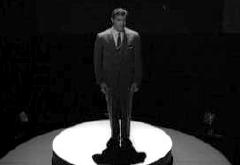
“NO TIME LIKE THE PAST.” An episode of The Twilight Zone, CBS, 7 March 1963 (Season 4, Episode 10). Dana Andrews, Patricia Breslin, Malcolm Atterbury. Radio adaptation: The Twilight Zone Radio Dramas, syndicated, circa 2002-2003, starring Jason Alexander.
“No Time Like The Past” is a Twilight Zone original series episode starring Dana Andrews (Laura, Where the Sidewalk Ends) as Paul Driscoll, a time-traveling physicist who comes to realize that, no matter how much you may want to, you simply can’t change the past. It’s one of those Twilight Zone episodes, which, apart from the somewhat clunky-looking scientific equipment one sees in beginning, does not seem remotely dated.
Indeed, the plot of “No Time Like The Past” and its theme of fatalism seem as timely as ever. That is one reason why Jason Alexander’s (Seinfeld) portrayal of Driscoll in the radio and audio drama version works so well.
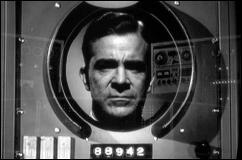
We begin with Paul Driscoll (Andrews) in conversation with his colleague, Harvey (Robert F. Simon). They’re in a laboratory. Driscoll is standing in a crude time machine that he invented. Light and shadow play prominent roles, both literally and figuratively, in this scene. A man of both academic knowledge and unbridled humanism, Driscoll has an incredibly bleak view of the twentieth-century and he’s not remotely reluctant to make his views crystal clear:
“We live in a cesspool, a septic tank, a gigantic sewage complex in which runs the dregs, the filth, the misery-laden slop of the race of men.â€
It’s Driscoll’s intention to travel backward in time so as to change the present. He chooses three destinations: Hiroshima, in order to evacuate citizens before the atomic bomb is dropped; Nazi Germany before World War II, so he can assassinate Hitler; and on board the Lusitania, to halt the American entrance into the First World War. (In the radio play, Driscoll visits the same three points in time but in reverse order.) In all three situations, he fails to complete his task. He returns, disappointed, to the present and once again meets up with Harvey in the laboratory.
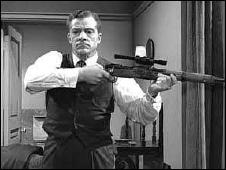
Driscoll now has a new plan. Rather than trying to change the past, he opts for living in it. Specifically, he wants to go back to 1881 and live in Homeville, Indiana where he can enjoy band concerts and lemonade. He’s read a book about the Midwest in the nineteenth-century and decides he wants to live in simpler times, before world wars and atom bombs. His naivety is galling.
When Driscoll gets to Homeville, he soon realizes that the past may not be all that great either. He ends up living in a boarding house with an armchair warrior who advocates for American imperialism in East Asia and, within a couple of days, President James Garfield is shot. Complicating matters is the fact that he begins to have romantic feelings for a schoolteacher, Abigail Sloan (Patricia Breslin) but soon realizes that he can’t do anything about it, lest he change the course of History.

Things get even worse for Driscoll when he realizes that some of Sloan’s schoolchildren are going to die in a fire. He read about it in the history book he carries with him. A man divided against himself, he can’t decide if he should intervene. In a sadly ironic twist of fate, Driscoll inadvertently ends up causing the very historical event he intended to stop. One of the perils of time travel, no doubt. Driscoll finally accepts that the past, as Harvey told him all along, is indeed inviolate.
Dana Andrews, best known for his film work in the 1940s, skillfully conveys the conflicted emotions the hopelessly tormented Driscoll. He convincingly portrays a man who is angry and sentimental, fearful and hopeful. In the slightly modified radio show version, Jason Alexander successfully pulls off the quite difficult feat of bringing this episode to life without the benefit of visuals. Alexander’s voice acting never once reminds you of his portrayal of George Costanza on Seinfeld.
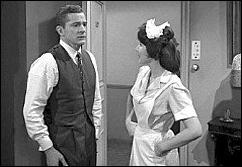
In conclusion, “No Time Like The Past” is a classic Twilight Zone episode that stands up to the test of time. The themes of nostalgia, sentimentalism, and wishing one could change the past so as to change the present remain poignant today.
While some contemporary listeners might be less familiar with the Lusitania than with the Second World War, the points in time that Driscoll visits remain alive in the American public consciousness. One could imagine a future reworking of the script to include references to the Vietnam War and to 9/11, but that might have to wait another couple of decades. It’s an episode both worth watching and listening to.
NOTE: The TV episode can be watched in its entirety on IMDb here.
Fri 4 Oct 2013
Posted by Steve under
Reviews[3] Comments
A REVIEW BY MARY REED:
MELVIN L. SEVERY – The Mystery of June 13th. Dodd Mead, hardcover, 1905.

The fateful date occurs more than once over more than a quarter century, in a saga involving Maoris on a mission of vengeance, an eloping couple whose ship passes that captained by the scorned fiance, the naive and about to be swindled inventor of a method of wireless telephony somewhat reminiscent of cell phones, a villainous businessman who out-Jaspers Sir Jasper, an actress taking the town by storm, assorted love affairs, and a number of other matters, all wrapped in a densely woven plot featuring among other things a cypher solved in a scientific manner, impossible locked room type disappearances, the struggle of rival groups of stockholders to gain control of a company following an event the author calls a “cool display of commercial depravity,” and more than one twist along the way.
George Maitland is called in to investigate a series of threatening letters, communications bearing the same device as that on the blade of the dagger used to murder the recipient’s father 25 years before, as well as on the hand of the assailant of a major character, and seen in various other places. And so murderous doings are set afoot and even Maptland admits “the method employed [for a murder] was unparalleled, fantastic, outre and bizarre in the extreme.”
I found this novel difficult to get into because of the lengthy opening sequence in a Maori village describing events that set the plot in motion. It might, I venture to suggest, have worked better if shortened and presented as a prologue, but don’t skip it! The story may unfold too slowly for some readers, but patience is advised as once into the thick of the plot, it rattles along like all get out.
I liked the idea of recurring fateful events on June 13th, and the explanations of how various matters were accomplished are fascinating. Some readers will guess the who and why since they are privy to information Maitland has not, but the how is what will almost certainly puzzle to the end, so it’s worth persisting with the novel even if you read a rather spotty copy on archive.org as I did!
Editorial Comment: This review is a follow-up to one written by Mary of The Darrow Enigma, also by Melvin L. Severy. You will find it here.
Thu 5 Sep 2013
CLYDE B. CLASON – Murder Gone Minoan. Rue Morgue Press, trade paperback, 2003. Original hardcover: Doubleday Crime Club, 1939. Pulp magazine reprint: Two Complete Detective Novels, Winter 1939-1940 (with The Cat Saw Murder, by D. B. Olsen). Hardcover reprint: Sun Dial Press, 1940.
Checking on www.abebooks.com just a few minutes ago, I found only one copy of the Crime Club edition for sale: Near Fine in a Near Fine jacket. Price: a mere $250.00. Further searching revealed a few other copies on other venues, one being a former library copy with no jacket. Price: a much more reasonable $35.00.
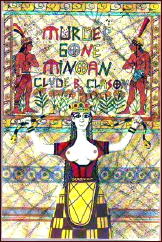
But if $14.95 is all you want to spend, this handsome trade paperback will do very nicely. This is but one of many classic mystery reprints coming from Tom & Enid Schantz of Rue Morgue Press, and they should be commended for a job well done, and for jobs yet to be done. (At the moment, the only other Clason title they’re published is The Man from Tibet, but perhaps others are on their way. Only sales will tell, I imagine.)
Only one thing is lacking, before I continue, and that is the original cover art, which as I recall was by Boris Artzybasheff. That gentleman no longer being available (or affordable) a fine piece of work by Rob Pudim was used in his stead. To my eye it’s a bit cluttered, but it Does Catch the Eye.
Clason’s series detective is an eminent Roman historian named Theocritus Lucius Westborough — Westborough for short — who also has earned a well-deserved reputation as a private investigator on the side. If this book is an example — which from my point of view it has to be, at least for the moment, since if I ever read an earlier book in the series, it was long ago and long forgotten — Westborough’s adventures are copiously filled with well-researched lore of ancient times, interspersed with mini-lectures on the same.
I’m jumping the gun here, but it’s Westborough’s knowledge of ancient history that helps crack a killer’s alibi — which is not quite fair to the reader not recently tutored in such matters — such as myself, I have to admit — but it’s a sizable step above nabbing a villain who reveals himself because he’s not aware that buildings do not have thirteenth floors, for example.
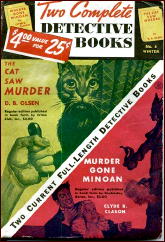
Just in passing: There is a deliberate misstatement on my part that is not quite correct in the last sentence of the previous paragraph, but if I were to speak more clearly, I would be revealing more of what Clason had up his sleeve than I should.
This, the seventh of ten cases Westborough is on record as having solved, takes place on an isolated island off the southern California shore, where first a valuable artifact is stolen — and Westborough called in — and then murder, when a missing butler is later found dead.
The owner of the island, a rich Greek businessman named Paphlagloss, is fascinated with the ancient Minoan culture, pre-historic Cretans whose civilization arose and fell even before the ancient Greeks, and his mansion is filled with valuable relics, artwork and jewels. Just the right place for skullduggery to be done, and with only a handful of suspects, one of whom is responsible for doing the dugging, it’s a perfect setting for a mystery.
Clason’s strength is in his characters and their dialogue. To my ears, the lengthy reports of letters and verbatim interviews of suspects are close to perfect. Other parts of the tale are excellent, while others, contrarily, are pure fuddle-muddle.
I like the following quote, for some reason, taken from pages 160-161. Paphlagloss’s daughter is having a private conversation with Westborough:
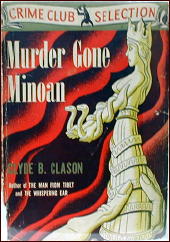
She shivered and drew the wrap closely to her slim body. “Why do things have to be in such a perfect devil of a mess?”
His mild eyes peered distressfully through his gold-rimmed spectacles. “The question, I should conjecture, has been propounded rather frequently during the four thousand years of recorded history. However, I am unable to recall a single instance where it was answered satisfactorily.”
“You are very wise!” she exclaimed.
He shrugged deprecatorily. “My wisdom is confined to a single fact. I have lived long enough to learn that most of my fellow creatures — and myself, as well — must of necessity be a little foolish.”
“What would you advise me to do?”
“I dare not advise you, my dear. The situation is too delicate. As delicate,” he added thoughtfully, “as the ripples of a Chinese nocturne.”
While it’s great to have this small gem of the Golden Age of Mysteries back again in print, I also have to suggest that it didn’t then, and it doesn’t now, have the staying power of one by a Queen, Christie, or a John Dickson Carr. Even so, and within its limitations, it is a gem in its own right, and no, they don’t write them like this anymore.
— January 2004
[UPDATE] 09-05-13. Checking on abebooks again just now, I found nine copies of the Crime Club edition for sale, ranging in price from $25 (bumped and frayed) to $300 (almost fine in jacket). Rue Morgue Press has a long informative profile of Clyde Clason, the author, and seven books in the Westborough series are now available from them. See below.
CLYDE B(urt) CLASON, 1903-1987.
The Death Angel (n.) Doubleday 1936. RM = Rue Morgue Press.
The Fifth Tumbler (n.) Doubleday 1936.
Blind Drifts (n.) Doubleday 1937. RM
The Purple Parrot (n.) Doubleday 1937. RM
The Man from Tibet (n.) Doubleday 1938.
The Whispering Ear (n.) Doubleday 1938.
Dragon’s Cave (n.) Doubleday 1939. RM
Murder Gone Minoan (n.) Doubleday 1939. RM
Poison Jasmine (n.) Doubleday 1940. RM
Green Shiver (n.) Doubleday 1941. RM








